They were the first. Lever pistols
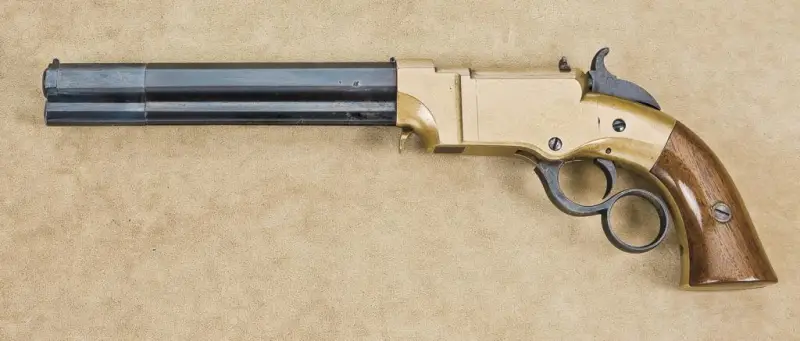
and I will move the Earth." Archimedes
stories about weapons. The interest in various kinds of unusual weapons is understandable. After all, this is a real detective story, an “adventure of thought”, the result of which, as a rule, is the most modern mechanism ever invented. And then it’s interesting how people come to this perfection step by step. Because they usually write about the results of such work. Why does one get the impression of some kind of insight that befell the creator of this or that mechanism, while behind him there are many of those who worked before him. It is also a story about the colossal inertia of thinking to which even the best minds are subjected.
Not so long ago, a material about Mannlicher’s 1896 “pistol with a lever,” which is also sometimes called the “Austrian Mauser,” generated a lot of response on VO. And many then wondered why the lever for cocking the shutter is on the right, because it’s inconvenient, etc.
However, the whole point is that this design was in line with, so to speak, the whole “school of lever pistols,” of which there were not two or three, but... many. That is, there was a certain collective opinion among the designers that leverage was not bad, it was not so easy to rise above it.
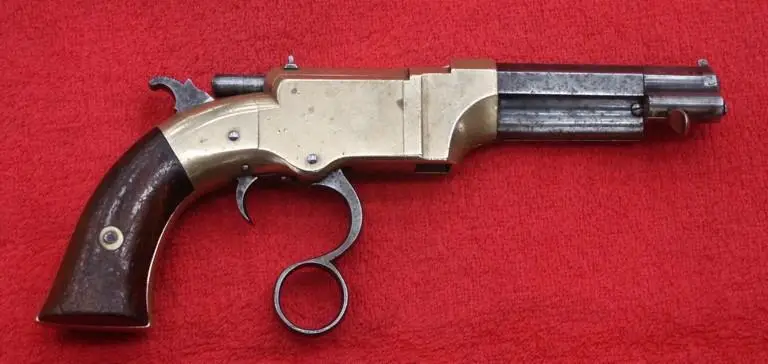
Pistol "Volcanic". Photography by Alain Dobress
Let's start with the fact that the desire of designers to create a portable weapon capable of firing several times in a row and at the same time devoid of a protruding magazine in the form of a rotating drum, already in the 50s of the XIX century was embodied in a pistol designed by Daniel Wesson "Volcanic" with an under-barrel magazine controlled by a lever.
The pistol did not work for many reasons, so already in 1856, Wesson, together with Horace Smith, began producing revolvers that were more common at that time.
But their idea of a pistol with an under-barrel magazine and a lever is by no means dead. A very similar pistol appeared in Austria in 1881, but chambered for cartridges with a metal sleeve, which, after being fired, was thrown back through the bolt.
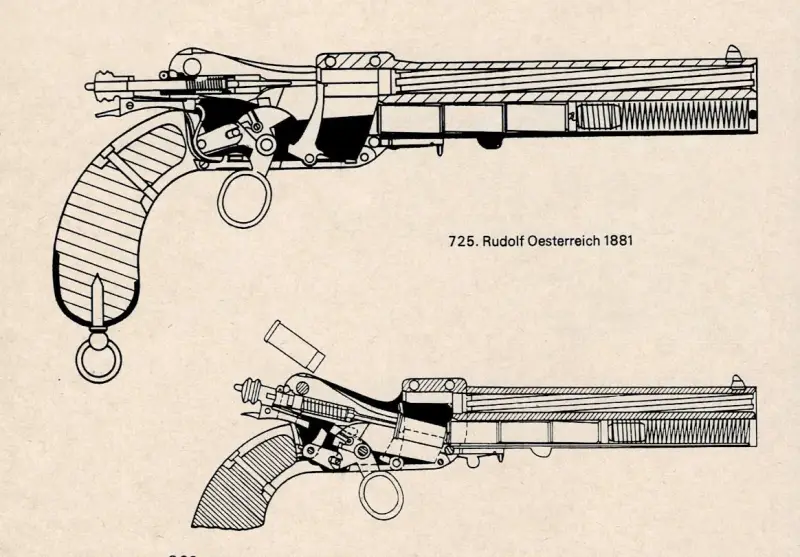
Here it is, this pistol! Drawing from the book by Yaroslav Lugz. “Hand Firearms”, Volume 2. Military Publishing House of the GDR, 1982.
Germany is very close to Austria. And there, an almost similar design was proposed in 1886 by... Paul Mauser! Who developed not only a pistol, but also a carbine for this design!
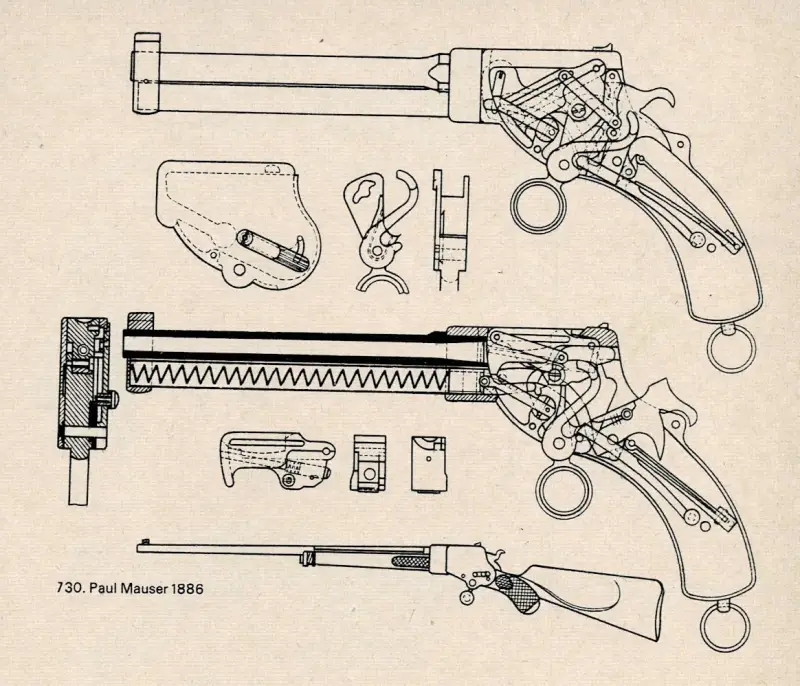
Paul Mauser pistol and carbine with under-barrel magazine and lever control. The movement of the lever with the ring back and forth ensured that the next cartridge was fed into the chamber, cocked and released. Same source
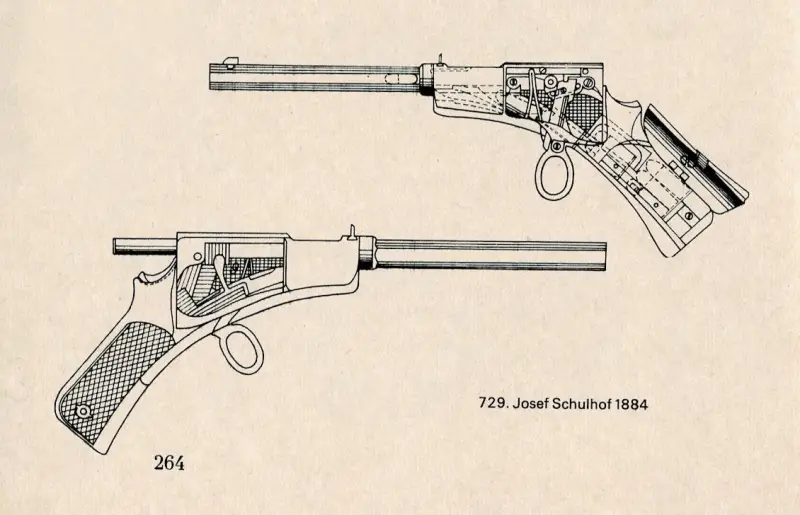
And two years earlier, Joseph Schulhof, again from Austria, proposed a pistol controlled by a swing lever and with a magazine in the handle... Same source
Several original designs of hand-operated firearms were created at the same time in France. The so-called expander pistols “Wonderful”, “Protector” and “Renovator” appeared there.
Finally, in 1887, a pistol with a lever drive was created in Austria by Franz Passer and Ferdinand Seidl. In it, a swinging lever controlled the bolt with a firing pin inside, and an under-barrel spring-loaded lever fed it cartridges from a clip located “Mauser-style,” that is, behind the barrel.
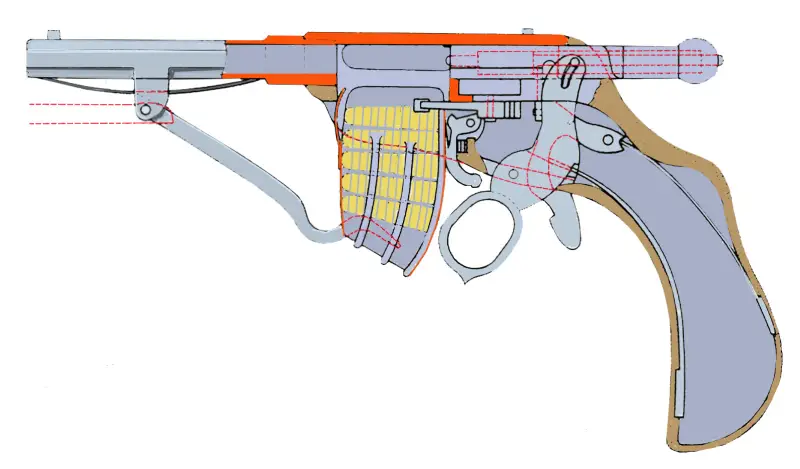
Diagram of the Passer and Seidl pistol of 1887. Fig. A. Shepsa
As you can see, there were quite a few lever pistols that operated with the muscular strength of the shooter. But only in comparison with revolvers they were a loser.
After all, the revolver had a tight cock at the trigger only when firing by self-cocking. By placing the hammer half-cocked, it was possible to shoot with minimal force on the trigger, while non-automatic pistols did not work in this way at all, and each shot required cocking and pressing the lever back. And although the designers tried to make this work easier by introducing additional springs, operating such a pistol was still not easy.
The Bohemian inventor Joseph Schulhof, who arrived in Vienna in 1868, already having a well-deserved reputation as a master gunsmith and inventor, also made his contribution to the creation of non-self-loading pistols. In the same 1887, he proposed his own version of a pistol with manual reloading using a lever swinging in a vertical plane. True, he managed to introduce something new into its design.
Unlike other similar designs, he placed a v-shaped spring in the handle, which facilitated the forward movement of the lever. The shooter only had to exert muscular force to pull the lever back, that is, to open the bolt. The barrel was locked by turning the bolt and placing it on two lugs.
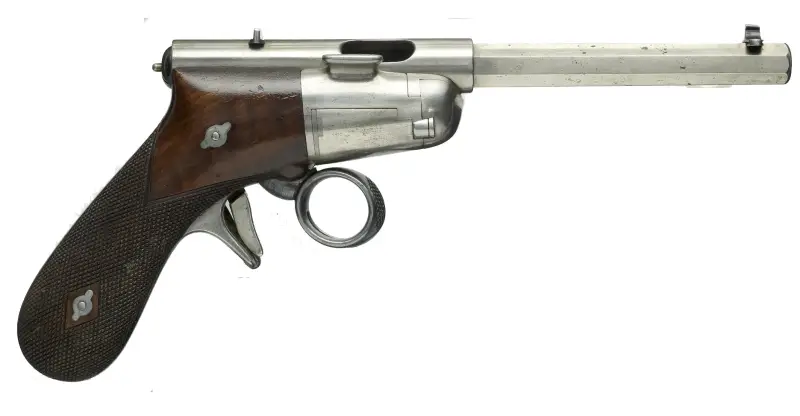
This photograph of the Schulhof M1887 pistol clearly shows all the external features of its design, including the lever under the barrel with a slot for the trigger and the magazine cover on the right side, which was opened by pressing the protrusion on it. Sights are the simplest. Photo of the company "Morphy Auction"
The trigger on the pistol was single action. The manual safety was designed to physically prevent the trigger from being pulled. A magazine with a circular arrangement of six cartridges was located in front of the trigger.
One of the last old-fashioned pistols of this type was the Karel Krynka pistol with a revolver magazine from 1892, in which a lever moved the bolt back and forth, which, when moving forward, fed a cartridge from the cylinder into the chamber. Moreover, Krynka’s magazine was not a cylinder with holes, but was a star with claws for holding six cartridges.
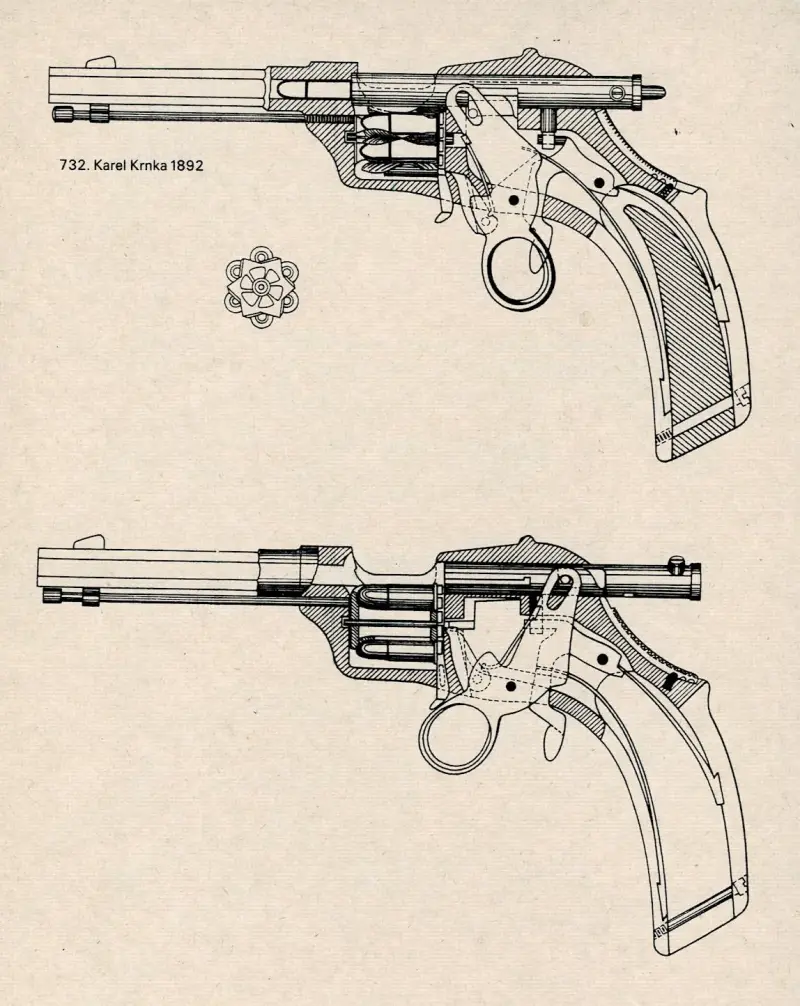
Diagram of the operation of the Krynka pistol of 1892. All its mechanics are very clearly visible here. Drawing from the book by Yaroslav Lugz. “Hand Firearms”, Volume 2. Military Publishing House of the GDR, 1982, p. 266
In general, all these designers were contemporaries and, one way or another, they at least heard about each other’s work.
Perhaps Joseph Laumann has advanced the furthest along this path. But when he began working on his pistol in 1889, he did not offer anything particularly new, and submitted his first application for the pistol he designed in 1890.
In the frame of this pistol, like all other such pistols, there was a cylindrical bolt, which moved back and forth due to the action of a lever. There is no information about whether it was made in metal, but since there is a document, the pistol was given a name - the Laumann pistol of the 1889 model.
Continuing to improve it, Laumann received a US patent in 1892 for the Model 1891 pistol. The most serious innovation in it was the cartridge supply system.
As you know, in Austria for some reason they fell in love with feeding cartridges using a pack and used burst loading not only in rifles, but also in pistols. So in this design, the feeder lever was mounted on an axis in the front of the store. The cartridges, together with a pack of five pieces, were inserted into it through the loading window at the top of the frame. Accordingly, inside the magazine for the pack there was a guide groove, and in its middle part there was a tooth for fixing it.
A clearly visible pack release button was located on the right side of the frame and had a fine notch. To load the pistol, you had to press this button and insert a pack of cartridges into the magazine. At the same time, the feeder lever pressed on the cartridges, and not on the pack, which, after shooting them, simply fell out of the magazine.
The design of the pistol had one interesting feature. After the shot, as soon as the shooter released the trigger, the loading lever moved forward under the action of a leaf spring.
At the same time, the bolt automatically moved back and removed the cartridge case from the chamber. The fuse was located at the rear of the frame and was a diamond-shaped lever with a transverse notch on the protruding part, fixed to the axis. The safety switch was turned off when the lever moved down. The total length of the M1891 pistol was 276 mm, the barrel length was 115 mm, and the weight without cartridges was 946 grams.
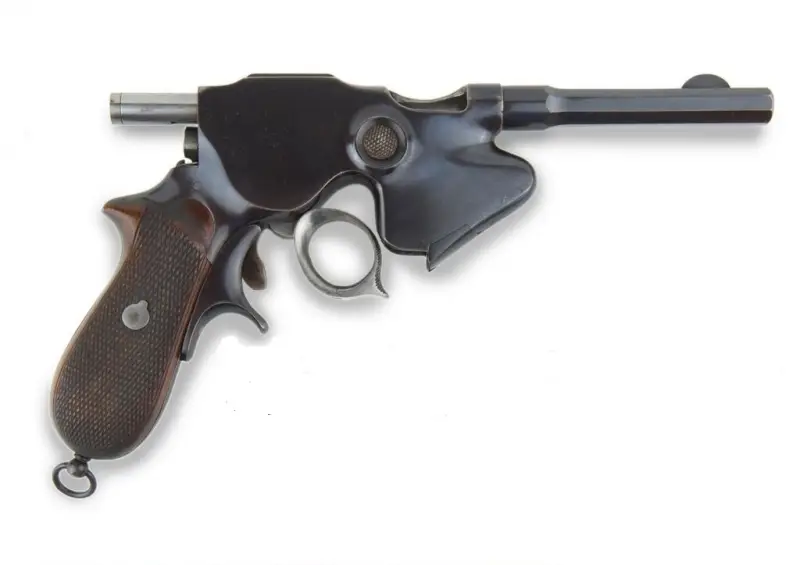
Here is this pistol with the bolt pulled back. Photo of the Military History Museum in Vienna
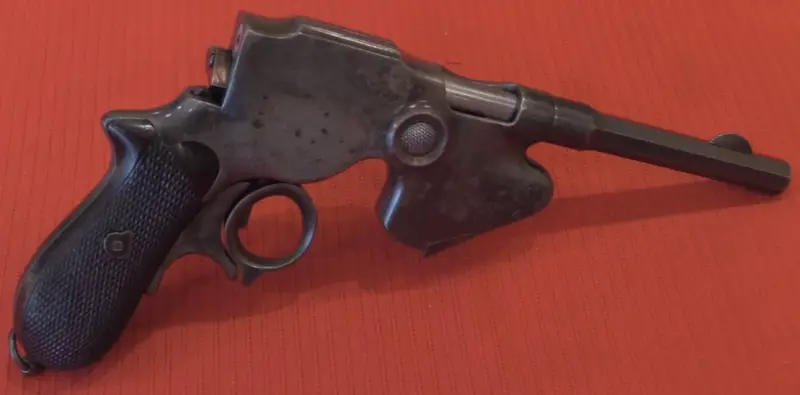
M1891 pistol at the moment immediately before firing. All that remains is to press the trigger inside the ring on the lever. Channel photo ForgottenWeapons
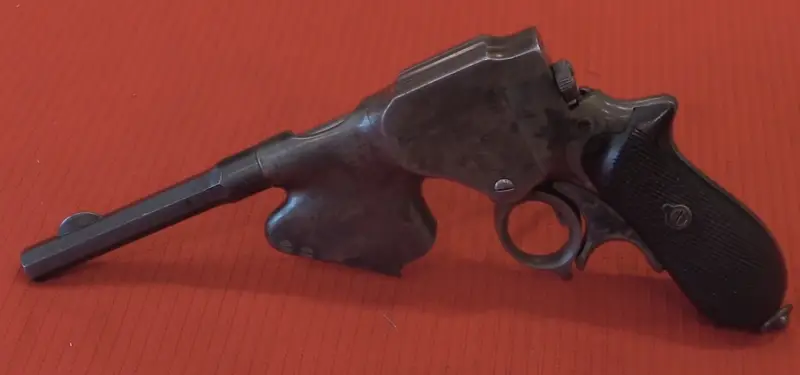
Pistol M1891. Left view. Channel photo ForgottenWeapons
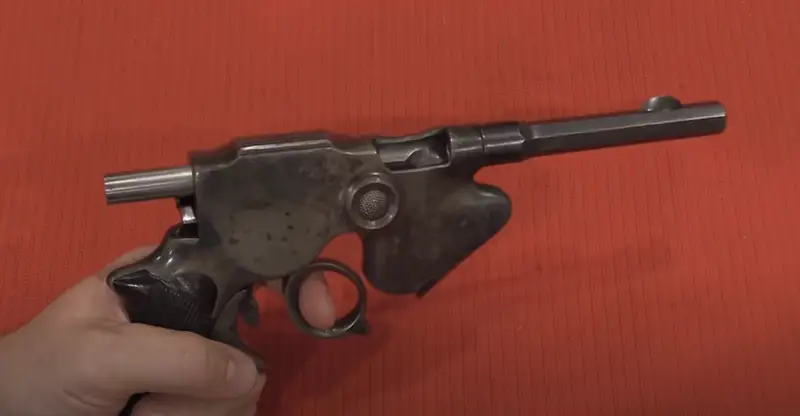
This is how the M1891 pistol was held when firing. Channel photo ForgottenWeapons
Lauman received a patent for this pistol in 1893, when, in fact, there was no longer any need for it, since in 1892, based on the 1891 model, he already made a self-loading pistol!
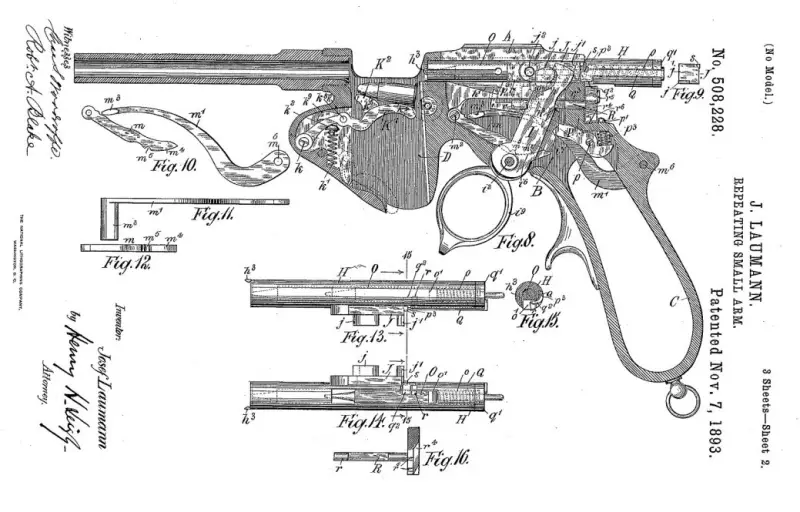
Diagram of an 1891 pistol from an 1893 patent
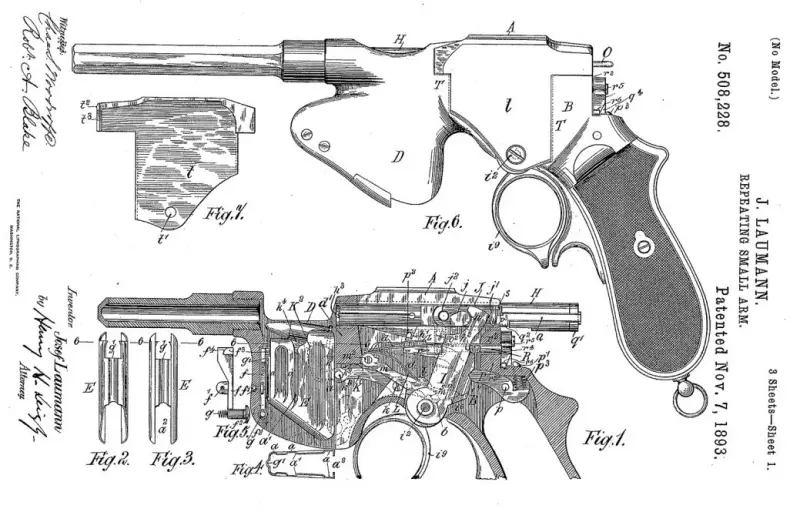
Appearance and diagram of burst loading from the 1893 patent
Sometimes this pistol is considered the very first self-loading pistol in the world, although there are other opinions on this matter.
It is interesting that Laumann’s self-loading pistol used a semi-free bolt, the opening of which did not happen just like that, but was slowed down due to high friction in the lever system. That is, it was... a friction shutter, which made it possible to reduce both the weight of the shutter itself and the power of the return spring. Moreover, Lauman calculated everything so that when manually cocking the shutter, no friction or braking would arise. Only when fired, which for those years was a very original solution.
Moreover, the bolt of the pistol was no longer cocked by a lever located in place of the trigger, but by a lever on the receiver on the right in front of the trigger. And, by the way, why he did exactly that is unknown!
Lauman patented his pistols in various European countries and in the USA, and the American patent of 1895 is especially interesting.
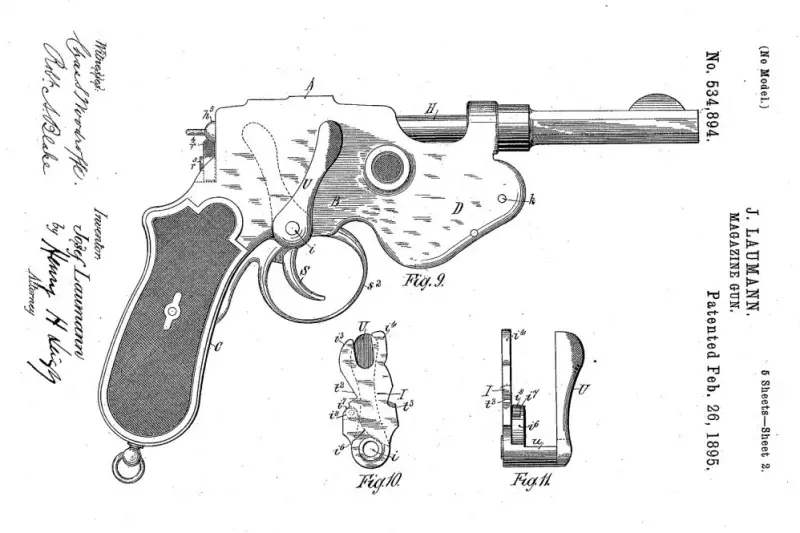
Second sheet of the 1895 patent. Shutter cocking lever
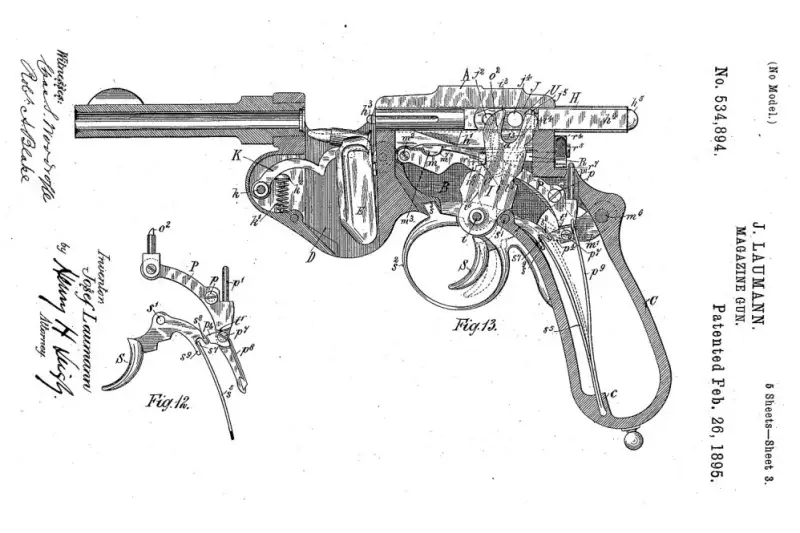
Third sheet of the 1895 patent showing a u-shaped bolt control lever
The fourth sheet contained images of the shutter, trigger mechanism and disconnector necessary for automatic firing: in the proposed version, the upper part of the trigger fit into a groove on the trigger lever. And finally, in the same patent, on the fifth sheet, for some reason a complicated cocking lever is shown, consisting of several parts, although one was enough!
Since Laumann could not simultaneously develop weapons, prepare patent documents, and promote weapons on the market, he entered into partnerships with the Schoenberger brothers and even transferred the rights to his patents to them.
In 1894, the Oesterreichische Waffenfabrik-Gesellschaft company in Steyr acquired all rights to the Laumann self-loading pistol from the Schönberger brothers. After which it released a small batch of pistols, called the Schönberger-Laumann pistol of the 1894 model. It used 8mm Schoenberger cartridges.
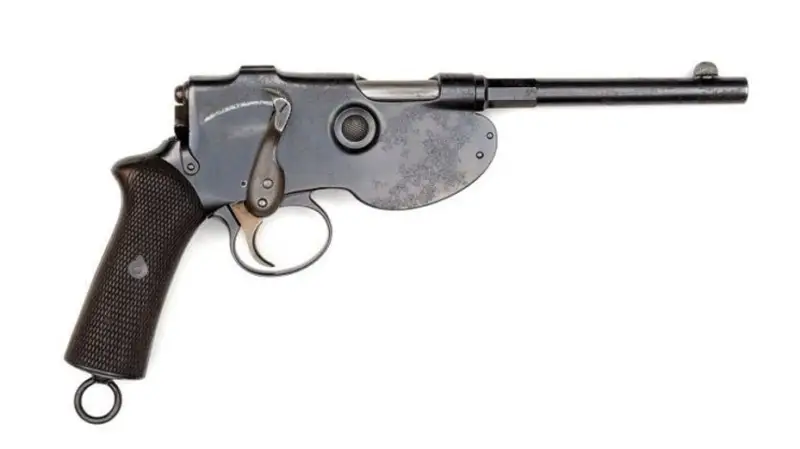
Schoenberger-Laumann pistol model 1894-I. Overall length: 321 mm, barrel length: 145,7 mm; weight: 1 g. Photo by Morphy Auction company
The Schönberger-Laumann M1894 pistol was released in two modifications: M1894-I and M1894-II.
The first feature was a large button for fixing the pack with a fine notch with a massive tide, as on Laumann’s own early pistols. For M1894-II pistols, the locking button was small and had a transverse notch. The M1894 pistol also had such an important improvement as a cocked striker indicator. If it was cocked, then a rod protruded from the back of the bolt.
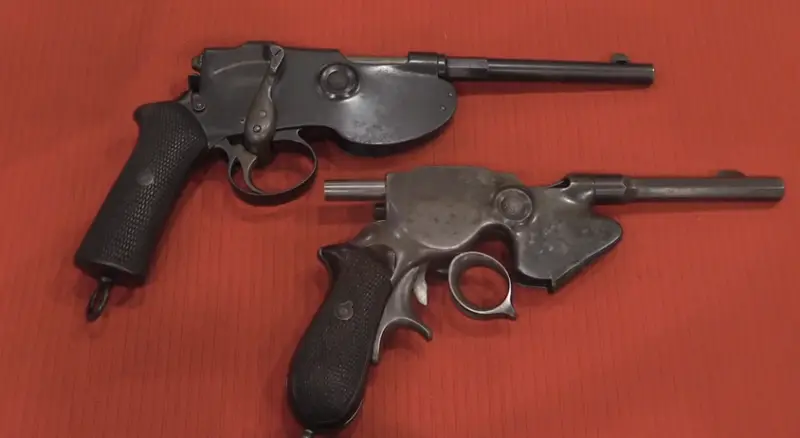
Differences between a Laumann self-loading pistol (top) and a manually operated pistol (bottom). Channel photo ForgottenWeapons
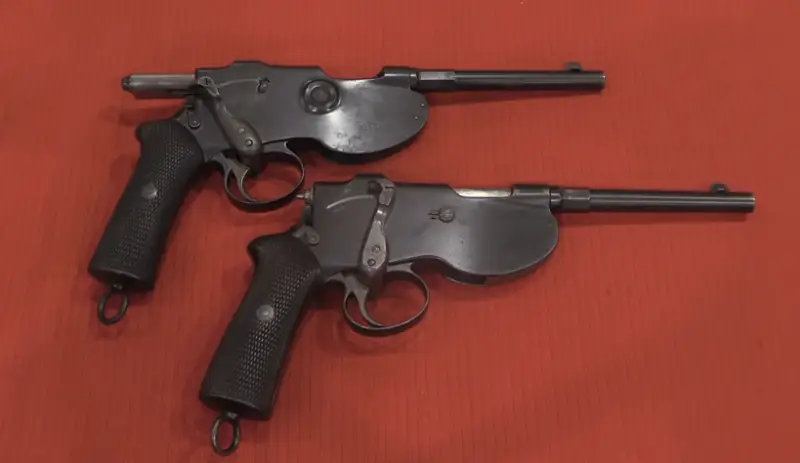
Pistol of the first (above) and second (below) modification of Schönberger-Laumann M1894-II. Overall length: 324 mm, barrel length 148,5 mm, weight 1 grams. Magazine capacity: five rounds of 256 mm Schönberger caliber per pack. Channel photo ForgottenWeapons
Pistols of all modifications were tested several times, but they never entered service with the Austrian army.
The Schoenbergers ended up losing a lot of money on this pistol, but Laumann lost his life!
Having received news of another refusal from the military, he decided to commit suicide, and in severe mental distress, he shot himself with one of his pistols, which eventually became very rare, so not even all military museums have them!
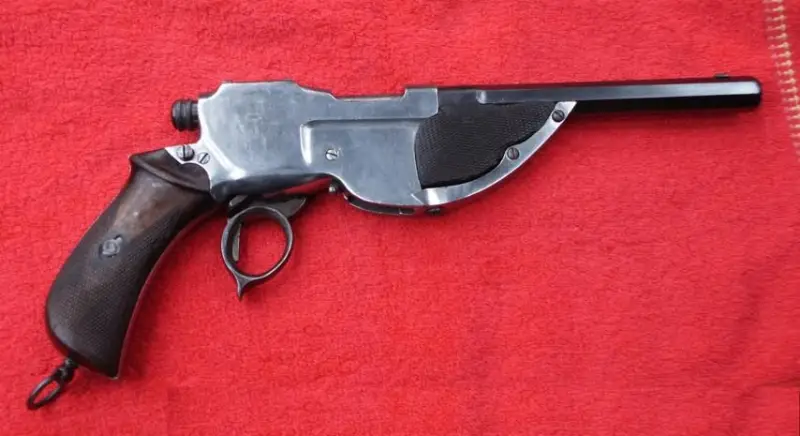
Gustav Bittner pistol. Its structure is similar to all other similar models, except for its design. For some reason, the “cheeks” of the front part of the magazine were made of wood, but with a notch! Photography by Alain Dobress
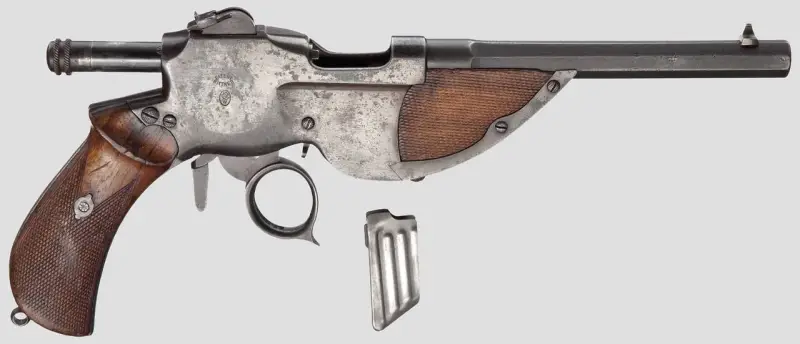
Bittner pistol and cartridge pack for it. Photo of the company "Morphy Auction"
Well, the last pistol with a lever can quite legitimately be considered the Gustav Bittner pistol of the 1893 model. Moreover, it was released in 1893, but received a patent only in 1896 - so today it is the latest lever pistol in the world!
Information